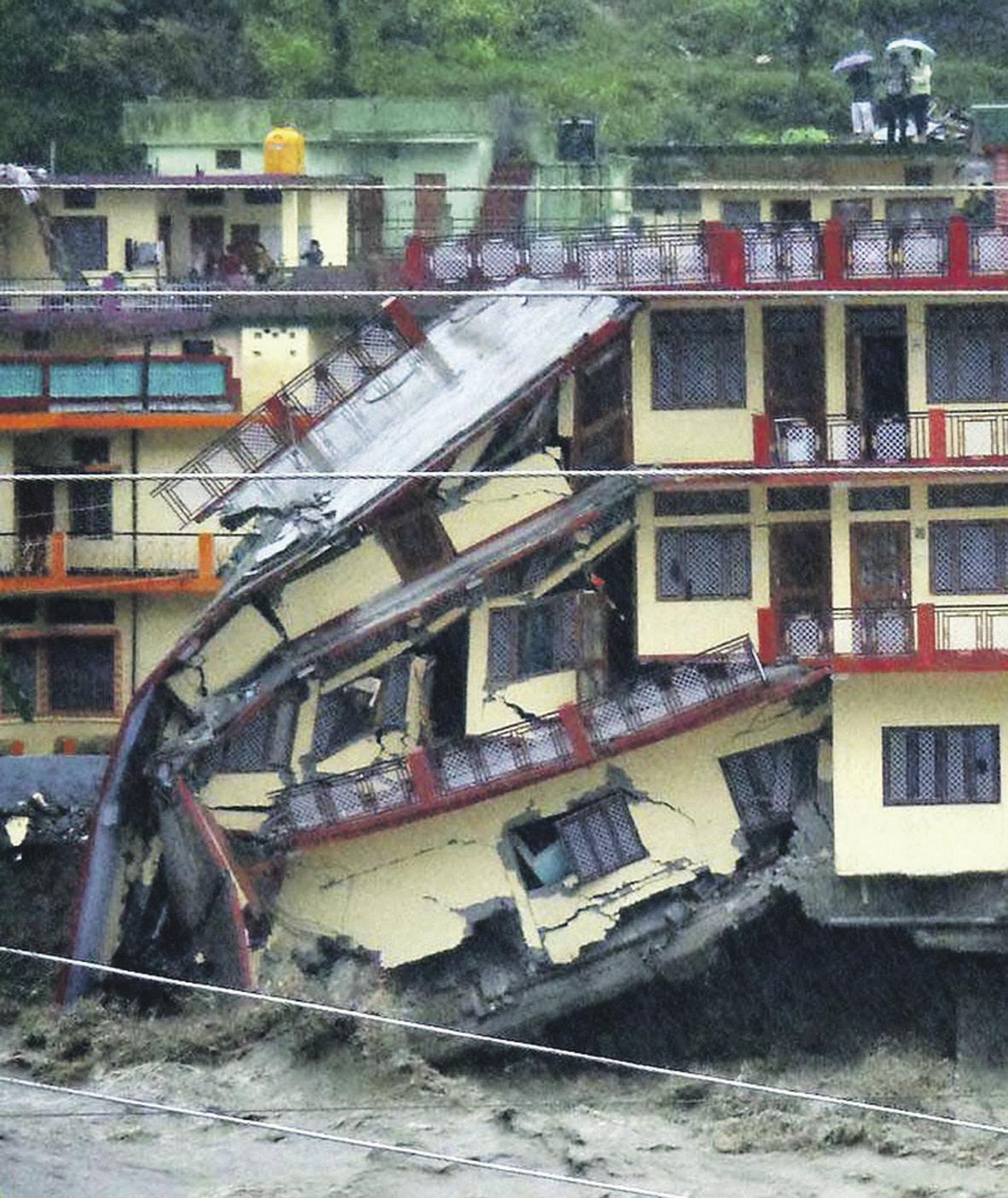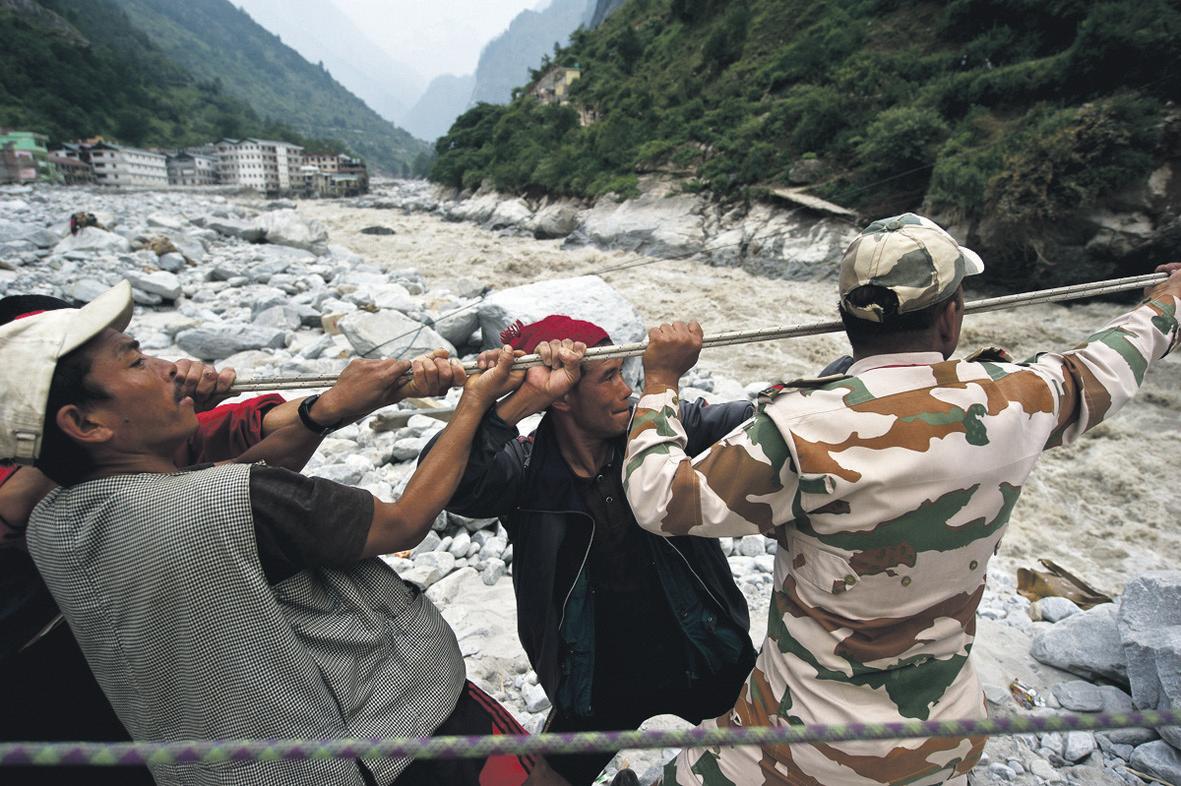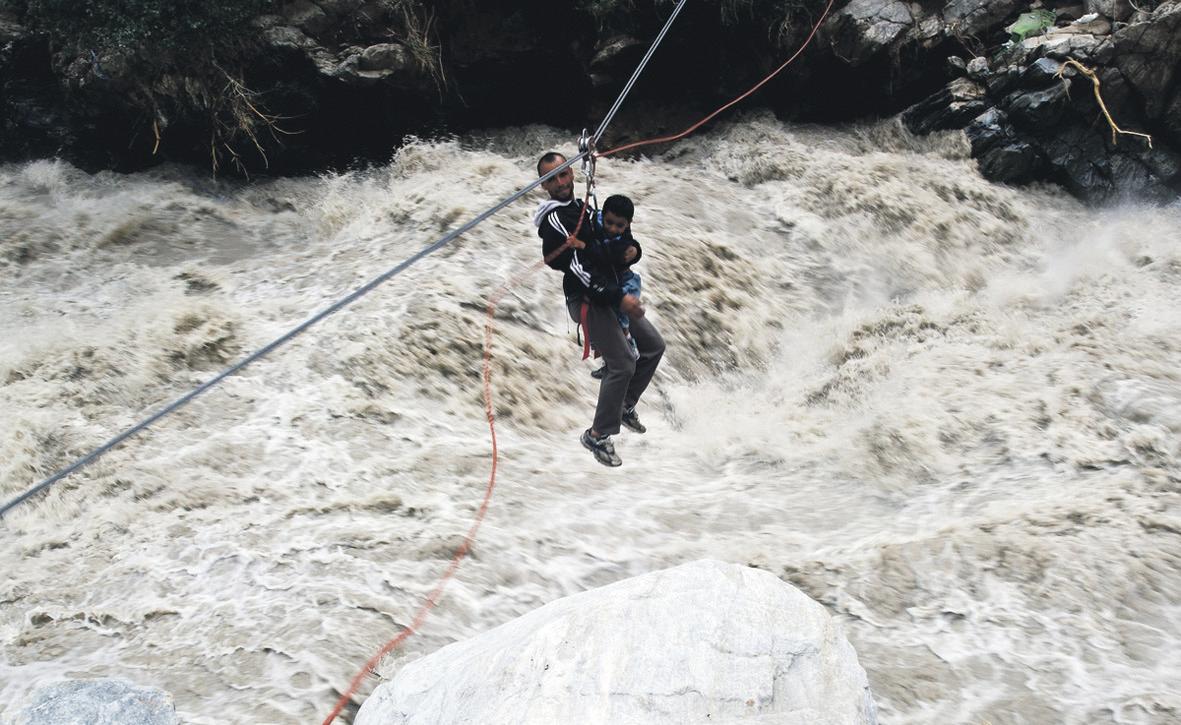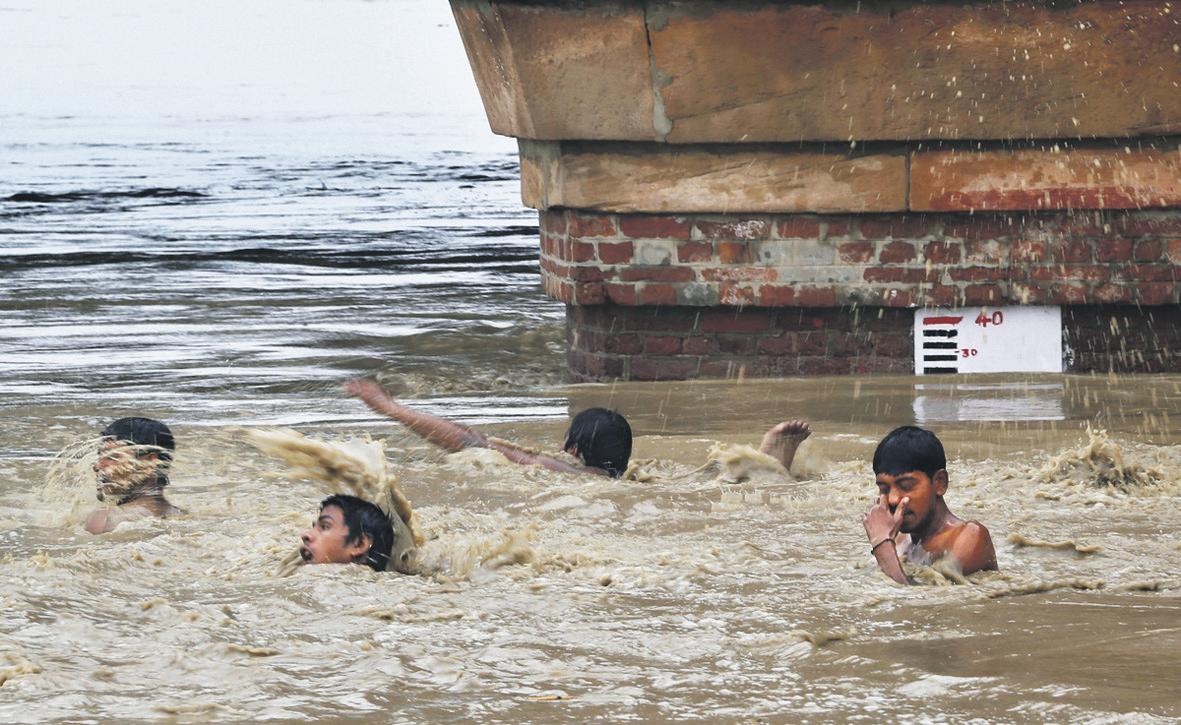
13 minute read
Himalayas
from 2013-07 Sydney (1)
by Indian Link
to Nirmal Ashram - all extended help of their volunteers and their resources.
The All World Gayatri Pariwar (AWGP), whose sprawling complex, Shantikunj, is housing many of the rescued people, is being used as a relief camp by many states. At Rishikesh, many of these institutions are offering free food, water, medicines. And some are not charging money for those getting photostat copies of photographs of their dear ones.
for penance!” He adds, “Then there is the plight of the survivors having to take clothes off dead bodies to save themselves, the chopper crash, the noble and honest defense personnel, and some of the local administration. For me, it is a big churning of emotions as each time I hear the name of a place in Uttarakhand, I am taken back to the wonderful memories of childhood.” A poignant and tragic feeling indeed!
Forewarned and ignored
What has come to light in recent days is that an alert was sent to the Uttarakhand government about the rainfall activity for 48 hours before the disastrous rains started around June 14, India
Meteorological Department official N Doraiswamy said recently. An IMD official based at Dehradun reiterated that warnings of heavy rains and landslide were sent to the state government. However, the Congress gave a clean chit to Uttarakhand Chief Minister Vijay Bahuguna, who has been facing flak for “ignoring” the advance warnings of very heavy rains by the meteorological department, saying it was satisfied with the state government’s rescue and relief work. The Met Office claimed that the Char Dham Yatra could have been halted in time, saving hundreds of lives. “The reasons (behind the tragedy) will be examined. The focus right now should be on evacuating stranded people, ensuring relief and rehabilitation and checking the spread of epidemic,” said Maken, spokesman from the Congress.
Maken said thousands of people have been left homeless and their houses uprooted. “We should rise above partisan politics and serve the people,” he added.
The hand of God?
But for the locals, the damage and devastation is the only thing they are talking about. The Haridwar ghats, as well as the temples are empty. The rains and landslides are God’s way of teaching mankind a lesson, they say.

“Rampant illegal construction on the banks of the river, corruption and looting the pilgrims have led to this. God was angry. It is his way. Otherwise, why would thousands of people who had come to pray at these shrines perish like this?” said Man Singh
Upreti of Dehradun. “This is god’s way to teach people a lesson,” added the 70-year-old. Others cite different reasons for the disaster. Neighbouring
Madhya Pradesh Chief Minister
Shivraj Singh Chauhan said the central government should declare a national environment policy to stop illegal construction and prevent a disaster like the one that wrecked Uttarakhand. Chauhan also asked for the Uttarakhand flash floods to be declared a national calamity. “When you tamper with nature, then nature will unleash its fury on you,” Chauhan said. Talking of the mushrooming of several buildings near rivers in Uttarakhand, he said, “Illegal construction and corruption go hand in hand”. Over 5,000 people from Madhya Pradesh were rescued and have returned home by helicopters, buses and trains. Chauhan declared a compensation package of Rs.2 lakh for the next of kin of those who died in the floods, and Rs.5 lakh for those who have lost their entire family.
Saviours of survivors
On hearing of the disaster, help poured into Uttarakhand from all over the country. Many religious and social organisation rose to the occasion, with one of them distributing thousands of food packets and even offering to conduct the last rites of those who died at Kedarnath. As the news of the devastation and deluge started pouring in, many religious and social organisations came out to extend a helping hand to those anguished people looking for their loved ones. From Yoga Guru Ramdev to All World Gayatri Pariwar (AWGP)
The Gayatri Pariwar also distributed food packets. “Of the total 10,000 food packets that were air-dropped, most were sent by Shanti Kunj,” an official of Shantikunj said. And international aid agencies have also come to the aid of the flood-devastated state. Among these are the ‘Waste Warriors,’ headed by Briton Jodie Underhill and a band of volunteers. Known as the ‘garbage girl’ of the mountains, she has embarked on the mammoth task of cleaning up after the disaster. “When I learnt about the disaster, I decided to adopt these hills as part of our next clean-up campaign,” Underhill said. “I was saddened to see how dirty it was everywhere. There is huge human waste. For the local civic authorities, rescuing the people is the first priority. But we will take care of it (removing garbage),” she added. Underhill has also come to the rescue of mules and horses that have been trapped by the flood waters in Uttarakhand’s Kedarnath-Badrinath axis. But it’s time to wake up India, said Underhill.
Search continues
For hundreds, the search for missing family members continues unabated. Photographs of loved ones taken on happier, merrier occasions, showing a family gettogether or celebrations now adorn the walls at relief camps, railway stations and bus stands. For the many hundreds of kin, photographs are the one way to trace their kin still missing even after a fortnight-long rescue and evacuation work carried out in flood-ravaged Uttarakhand.
At the Haridwar railway station, relief camps have been set up by many state governments whose people had come to Uttarakhand for the Char Dham yatra when the rain-flood tragedy struck. At the Shanti Kunj complex, headquarters of the spiritual and social organisation of All World Gayatri Pariwar (AWGP), three states - Madhya Pradesh, Gujarat and Odisha - have set up relief camps and many of their rescued people are staying in its sprawling complex.
One of the casualties of the rescue operations that shocked the nation was the crashing of an Indian Air Force rescue plane on June 25
Laxmikant Sharma, a minister in Madhya Pradesh Chief Minister Shivraj Singh Chauhan’s cabinet, said they have heard many a horror story of people being trapped and being swept away in the waters. “A family saw two of its members swept away by the water. They watched in horror. They were mute spectators,” Sharma said. But there were some stories of hope too. “We met three boys,
The National Disaster Management Authority (NDMA) declared the Uttarakhand devastation a “severe natural disaster” and requested leaders not to politicise the issue

- they all tell the story of families torn apart by a force greater than mankind. All of them are missing. For the anguished families, it has been a hellish 15 days.
Fatigued and looking fragile was Rajkumar Singh from Rajasthan, searching for his 50-year-old brother, sister-in-law and their three children. Sneha Sharma, 21, desperately searched in hospitals, police stations and relief camps for her parents, two brothers and two sisters who had gone to Kedarnath shrine. Carrying photographs of her family, Sharma met an army official, who after seeing her 17-year old sister Jyoti’s photograph, told her that they have cremated her. “He told me that they found her body and cremated her. I don’t know about the rest of the family members. No one is able to help me out. Where should I go, what should I do,” she wailed. She said if she had been the only survivor in her family she would have killed herself. But she has to think of a younger sister who is in college.
Similarly, Subhash Chandra Sharma from Ghaziabad was desperately searching for his nephew, his wife and their three children. When he failed to get any news, he registered a missing persons’ report.
Pankaj Pokhiriyal said so far they have registered 794 missing cases. “We are giving people a simple form and asking them to attach photos too,” Pokhriyal said. Ten years in service, the police officer from Tehri Garhwal said he has never ever seen such devastation.
“I have been born here and spent my entire life. But have never seen such a massive destruction where hundreds have died and hundreds are missing. I think it’s God’s way numbers live on tourism.
According to one business study, the loss to the tourism industry on account of the floods is estimated at Rs.12,000 crores. Uttarakhand ranks eighth among all states on the tourism map. Major pilgrimage centres have also suffered terrible damage and pilgrimages to places like Kedarnath and Badrinath, home to among the most revered Hindu shrines, are unlikely for months, if situation in the state.
He has spelled out enhanced rates of compensation, which make sense in the case of lives lost, those injured, and property damaged, but are merely symbolic in the case of circumstances such as farm land being washed away.
Rs 10 lakh, each, will be paid to the families of those killed in the IAF chopper crash, and special pensions and other benefits to the deceased members of the Uttarakhand police.
Help has been offered by who were part of a large group of 18 people, coming back alive. They told us that when the first floor of the lodge where they were staying was filled up with water, they went to the second floor. But when the second floor too filled up, they held on to the window grills and saved their lives. “They were inconsolable. It was difficult for us to make them understand. Their entire families have died,” said Sharma, who leads the team of over 50 state officials tracking and rescuing people. He said they had also come across people who walked for 2-3 days, reaching a relief camp in Rishikesh or were picked up on their way from the main road. “Many people have lost their clothes, their footwear and their vehicles. Apart from offering them food, water and medicines, we offer them chappals, soap, toothpaste and tooth brush,” Sharma stated.
The scene is the same at the Rishikesh too. Large posters of loved ones can be seen from far off. The Rishikesh bus stop does not look like a normal interstate bus stand; as one side of the bus stop wall has been taken over by photographs and posters, the other side has been taken over by the police and by voluntary and religious groups offering people free food, water and medicines.
Station Officer of Rishikesh of punishing us humans. What else can we call it,’ he said.
Blow to tourism
The devastating floods have strangled the booming tourist industry too, and experts say recovery will take a long time. Mass cancellations by tourists and pilgrim groups have taken place in Uttarakhand, affecting even places that did not experience what has turned out to be one of the worst ever natural disasters in the state.The cancellations extend to the months of July, August and September.


“The impact of the floods is being felt by hill stations like Mussoorie, Nainital, Jim Corbett, Dehradun, Lansdowne and Kasauni,” said Richa Goyal Sikri, director of STIC Travel Group. “Travellers are reconsidering their plans due to exaggerated reports of the bad weather and road conditions,” she said.

The cancellation rates are touching an alarming 50 percent, a huge blow to a region where large not a few years.
Industry insiders say the state will be able to bounce back by the next tourism season only if all government departments and bodies in the state work in coordination.
“The government says it will take three years for the state to get back to normalcy but the duration will be longer seeing the loss of infrastructure,” warned George Kutty of the Travel Agents Association of India.
Financial aid
Chief Minister Vijay Bahuguna has announced the first round of measures, mostly financial, to deal with the post-disaster other states as well, with the Andhra Pradesh government announcing Rs.50 crore for relief works and for construction of four pilgrim amenities centres.
Chief Minister N. Kiran Kumar Reddy announced that Rs.10 crore would be given to Uttarakhand government for rescue and relief works. Another Rs.40 crore will be spent through Tirumala Tirupati Devasthanam (TTD) for construction of pilgrim amenities complexes, said a statement from the chief minister’s office.
Chief Minister Bahuguna said that children in areas hit by the floods would be given Rs.500 and college students Rs.1,000 each as intermediate relief.
Rescue and rehabilitation
The Uttarakhand government has now set up a reconstruction and rehabilitation authority to oversee relief work in the state, while Chief Minister Bahuguna announced setting up of the Uttarakhand Rehabilitation and Reconstruction Authority. In a far-reaching decision, the chief minister said no permission would be given henceforth for construction along riverbanks.

Thousands of dwellings and buildings along riverbanks have been washed away or destroyed in the floods. The chief minister announced that water and power bills for flood-affected people would be waived. He also said that kin of all missing people should report to the authorities, so that compensation can be given to them on the basis of an affidavit.



As the rescue operations continue, the authorities are now confronted with the mammoth task of clearing up the debris, searching for bodies and disposing them of properly. The chief minister announced that a team of 200 people, including officials from the police, health, animal husbandry experts and sanitation, are being rushed to Kedarnath to collect DNA samples of bodies. Various state governments have been asked to verify the list of missing people and if they are not traced in a month, they will be declared dead.
The National Disaster Response Force (NDRF) has sent a team to the state for locating bodies under the debris and to deal with decomposing corpses of humans and animals, which could pose a severe health hazard and could possibly cause an epidemic. To hasten the process, the state government has sought earthexcavating machines from the central government. It has also sought 100 tonnes of bleaching powder to help dispose of the carcasses of animals killed.
Commentary
Gurinder Kaur is on the board of Voluntary Action Network India and, having worked for Oxfam, she has first hand experience in disaster preparedness and relief and rehabilitation. Ms Kaur comments, “The Uttarakhand tragedy needs to be understood in its entirety. Natural river courses and other drains seldom respect human-made concrete, stone or tar structures. On the contrary, it must be the other way about. We must keep habitation out of the expected and known ways of the occurrence of natural phenomena. In the case of the Uttarakhand disaster, we now have all the analysis and narratives about what happened, what really could have been done before, during and after the mélange of rain, flood and mud overtook the collective lives of thousands of people.
We know that scores of hotels and other buildings had been built in violation right on the flood courses of rivers rapidly flowing across steep gradients. We know that the timber mafia, the stone mafia and the construction mafia made the region far more vulnerable by taking away humungous quantities of wood, stone, sand and other materials. We also know now that greedy tour operators colluded with equally greedy hotel owners to disregard the actual carrying capacity of the state’s roads, transportation and dwelling units.
Most astonishingly, we know that advance weather forecasts and flood and landslide warnings were issued by the meteorology department. Officials, leaders and other responsible people were informed about the prediction of widespread heavy rain. Alerts were issued for halting the yatras to the Chaar Dhams for four days and for moving the pilgrims already in the Chaar Dhams to safer locations. Did these warnings fall on deaf ears?
Although it would seem that such was the case, we know now that the warnings were received and read. What then was the matter? The officials and the others responsible for responding to disasters and in charge of protecting and saving lives knew there was a drill to be followed. But it is evident they did not know when or how to kick it in.
Inadequate training or the lack of it may turn out to be the big gaping hole that let slip a preventive response. It was widely believed that such warnings of heavy rain were routine and nothing really happened most of the time to cause panic.
Oddly and simply enough it is all about training. Each and every resident of Uttarakhand, permanent or transient, official or ordinary citizen, must be exposed to appropriate and adequate disaster preparedness and response training. Training must be so good that even if woken from sleep, a response should begin at once.
In a disaster prone and ecologically fragile habitat, expect the unexpected to happen. Community level preparedness and response training need to become the backbone of a statewide disaster management strategy. For the governing apparatus, repeated trainings - at least three a year - must be mandatory. Disaster preparedness and response must permeate our very consciousness”.
Also commenting on the situation, a powerful editorial published in the Garhwal Post on June 18 states “The problem lies with the lack of a comprehensive development policy that focuses on what is sustainable as against mere tokenism… It is time to ask whether it is better to develop well planned urban settlements than to try and support scattered habitations in the fragile mountains of Uttarakhand. The people are already voting with their feet, taking the first opportunity to get out of the harsh and increasingly difficult life in the hills. It is for the government to meet this challenge in either a positive manner, or waste funds and energy in the futile effort to shore up a collapsing way of life.
The hills can nurture only a limited number of people in the context of modern day lifestyle demands. Funds would be better utilised in developing the urban infrastructure for the people coming in anyway, rather than spending it on building that which will be destroyed in the next landslide, flood, cloudburst, etc.”
The Garhwal Post editorial of June 27 comments on the state’s post-disaster policy saying, “The shape that Uttarakhand’s development has taken is the cumulative result of historical forces, political and economic aspirations, central and state policies, and the raw energy of the people trying to make a living. All of this needs to be reviewed to establish what the state wants to change and what it will stand by”. It further comments, “The tragedy was certainly ‘man-made’ in that the forces of nature were ignored in the rush for development. However, there is an extent to which the people of Uttarakhand need to be apologetic for the speedy and unplanned growth. After all, what is better? Youth involved in chaotic entrepreneurship; or jobless and Maoist fodder?”
Caritas: www.caritas.org.au









